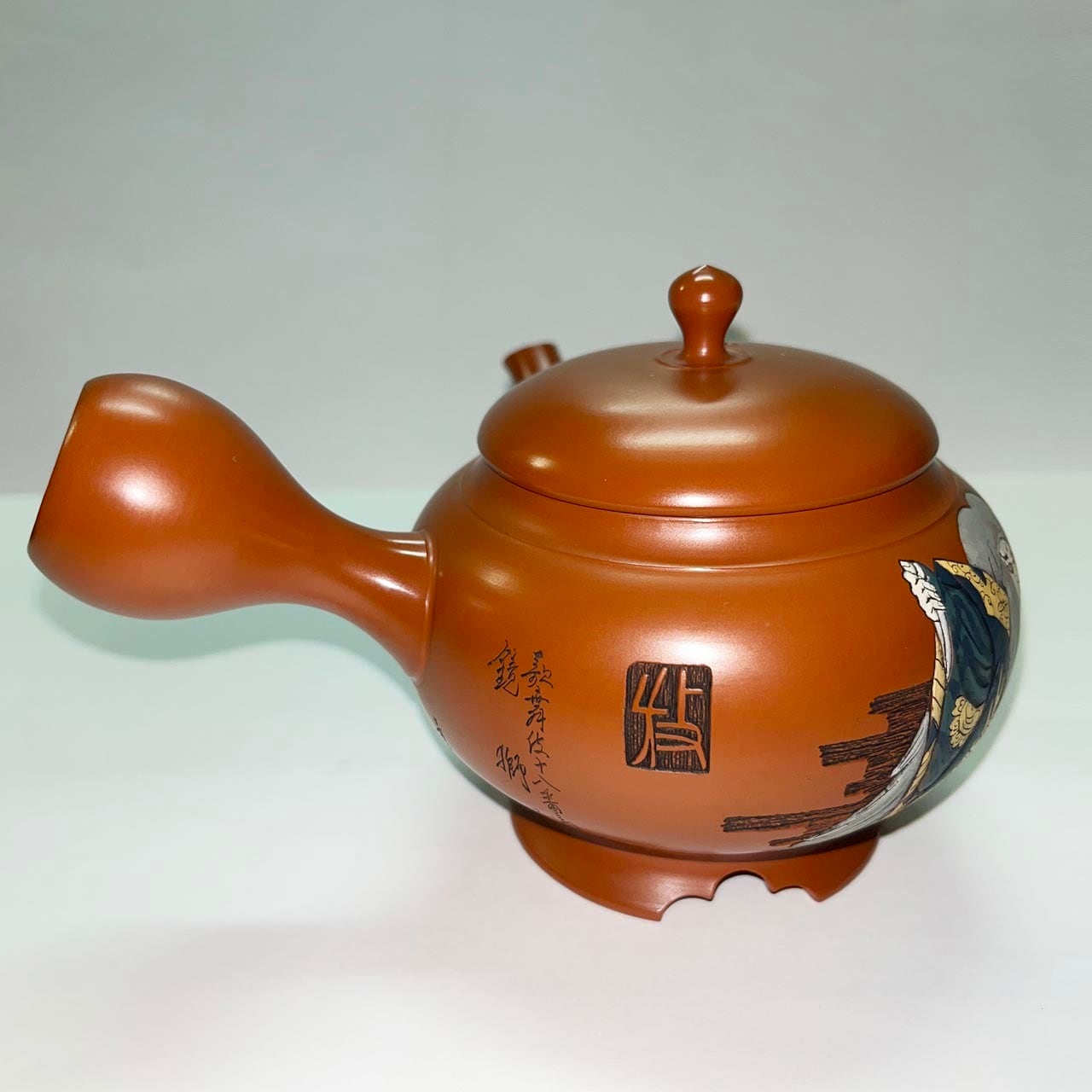







常滑焼 「歌舞伎十八番 鏡獅子」の精密な彫刻急須 吉川雪堂、吉川壺堂作 正規の箱なし / Tokoname yaki, "Kabuki Jyuhachiban Kagamijishi" by Setsudo Yoshikawa and Kodo Yoshikawa, Precisely carved teapot, No original box
¥220,000 税込
残り1点
品質や美しさにこだわった「歌舞伎十八番 鏡獅子」の精密な彫刻急須をご紹介します。吉川雪堂と吉川壺堂の作品です。
この急須は、神秘的な鏡獅子のモチーフが美しく描かれており、豪華な彩りと緻密な彫刻が魅力です。鏡獅子は歌舞伎の舞台で一番華麗な演目として知られ、その迫力と美しさは圧巻です。この急須にはその歌舞伎の世界を感じることができます。
吉川雪堂、吉川壺堂の急須は、高い技術力と独創的なデザインが評価されています。職人の手によって一つ一つ手作りされ、その美しさと品質は一流です。茶道を愛する方々からも絶大な支持を得ています。
国内外のコレクターやお茶好きの方々に大変ご好評いただいています。日本の伝統工芸を愛する方々にぜひお手に取っていただきたい一品です。
---------------------------------
Q:常滑焼(とこなめやき)とは?
A:常滑焼は、日本の愛知県常滑市を中心とした陶磁器の伝統的な窯元です。「日本六古窯(にほんろっこよう)」(瀬戸・常滑・信楽・丹波・備前・越前)と呼ばれています。平安時代末期には、知多半島の丘陵地に常滑を中心に穴窯が広がり、山茶碗や壺などが作られました。この時代に作られた焼き物は古常滑と呼ばれます。中世常滑窯は当時最大の生産地で、大型の皿や茶碗が特徴でした。室町時代には生産が拡大し、大型の甕や壺が遠隔地へ船で運ばれました。江戸時代には真焼けの陶芸品が増え、明治時代には平地窯や機械化が導入され、食塩焼きが現れ、土管・焼酎瓶・建築陶器、衛生陶器も登場し、近代産業へ進化しました。大正から平成にかけて技術と生産が急速に進歩し、現在の状況に至りました。
Q:吉川雪堂(よしかわせつどう)、吉川壺堂(よしかわこどう)とは?
A:吉川雪堂は常滑を代表するろくろ師です。彼以外にはこれほど精巧な急須を作る職人はいないのではないでしょうか。雪堂の急須を求めて遠方から多くの人々が訪れます。見た目は普通の急須ですが、一切の線や凹凸がなく、完璧な滑らかさが特徴です。また、茶濾しも独自の技術で500から大きな急須には1000個近い穴を開けます。これらの技術は雪堂だけのものです。彫師の吉川壺堂は、雪堂の兄です。雪道が作るほぼ全ての急須に彫りを入れています。
=======================
We would like to introduce the precision carved teapot of "Kabuki Jyuhachiban Kagamijishi" which is particular about quality and beauty. Works by Setsudo Yoshikawa and Kodo Yoshikawa.
This teapot is beautifully drawn with a mysterious Kagamijishi motif, and is attractive for its gorgeous colors and intricate carving. Kagamijishi is known as the most splendid performance on the Kabuki stage, and its force and beauty are overwhelming. You can feel the world of Kabuki in this teapot.
The teapots of Setsudo Yoshikawa and Kodo Yoshikawa are highly regarded for their high technical capabilities and creative designs. Handcrafted by artisans, each piece is top-notch in beauty and quality. It has gained tremendous support from those who love the tea ceremony.
It is very popular with domestic and foreign collectors and japanese tea lovers. This is a must-have item for those who love traditional Japanese crafts.
---------------------------------
Q : What is Tokoname yaki?
A : Tokoname yaki is a traditional pottery pottery centered in Tokoname City, Aichi Prefecture, Japan. At the end of the Heian period (794-1185), anagama kilns spread across the hills of the Chita Peninsula around Tokoname, known as the "Six Ancient Kilns of Japan" (Seto, Tokoname, Shigaraki, Tanba, Bizen, and Echizen). Tea bowls and pots were made. Pottery made in this period is called Ko-Tokoname. Medieval Tokoname kiln was the largest production area at that time, and was characterized by large plates and bowls. During the Muromachi period, production expanded, and large-scale jars and pots could be obtained by ship to remote areas. In the Edo era, the number of ceramics made with true ware increased, and in the Meiji period, flat kilns and mechanization were introduced, salt-grilled products appeared, clay pipes, shochu bottles, architectural ceramics, and sanitary wares appeared, evolving into a modern industry. Technology and production progressed rapidly in the future, leading to the current situation.
Q : Who are Setsudo Yoshikawa and Kodo Yoshikawa?
A : Setsudo Yoshikawa is a potter's wheel representative of Tokoname. I don't think there are other craftsmen who make such elaborate teapots other than him. Many people come from far away to buy Setsudo's teapots. It looks like an ordinary teapot, but it is characterized by perfect smoothness without any lines or unevenness. In addition, the tea strainer is also made with our own technology, with 500 to 1,000 holes in a teapot. These techniques are exclusive to Setsudo. The sculptor Kodo Yoshikawa is Setsudo's older brother. Almost all teapots made by Setsudo are carved.
-
送料・配送方法について
-
お支払い方法について
¥220,000 税込




























